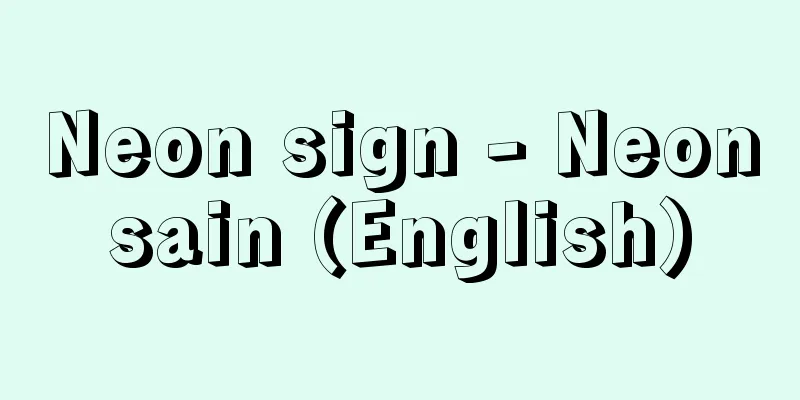Neon sign - Neonsain (English)

|
A type of electric sign in which neon tubes that emit red, green, blue, white, etc. are lit by a neon transformer and the letters and colors can be changed to flash using a flasher or dimmer. They are installed on rooftops of buildings and used as a means of advertising. The neon tubes used in neon signs are discharge lamps that have electrodes on both ends of a long, thin glass tube and are filled with neon gas or a mixture of mercury and argon, and utilize the light emitted by the positive column due to glow discharge. There are four types of glass tubes: clear glass tubes, fluorescent tubes with a phosphor coating on the inner wall of a clear glass tube, colored glass tubes, and colored fluorescent tubes with a phosphor coating on the inner wall of a colored glass tube. The red color is produced by sealing neon gas in a transparent glass tube, the blue color is produced by sealing mercury and argon gas in a transparent glass tube, and the green color is produced by sealing mercury and argon gas in a green fluorescent tube. Research into discharge lamps began with the Geissler tube, which was created around 1850. This was used to study discharge and fluorescence phenomena in Germany and France. Later, the Crookes tube was invented in 1872, but the first light source utilizing discharge phenomena was the Moore tube, created by Daniel McFarlan Moore (1869-1936) in 1893. However, this was inconvenient to use and did not become practical or widespread. In 1910, G. Claude exhibited a neon tube in Paris, and in 1918, André Claude (G. Claude's cousin) put neon tubes to practical use by lighting signs on the streets of Paris. Since then, it has developed significantly and become widespread for advertising purposes. The first full-scale neon sign in Japan was an advertisement on the roof of Shirokiya, Nihonbashi, Tokyo (later the Tokyu Department Store Nihonbashi branch; closed in January 1999) in July 1926 (Taisho 15). Neon signs are usually lit by wire-wound or inverter neon transformers. There are various secondary no-load voltages below 15,000 volts, and short-circuit currents are 20 milliamps for normal types and around 40 milliamps for high-brightness types. A flasher is installed on the primary side (low-voltage side) of the transformer, and various flashes are produced by the copper plate notches on the rotating roller. The basic flashes are constant (all lights on), all lights off, sequential lights on, sequential off, running flashes (the flashing stages move and follow), shadow forward flashes (the unlit parts are sent in sequence), bidirectional flashes (flashing in two directions, vertically and horizontally), and random flashes. By independently adjusting the brightness of the red, green, and blue neon tubes with a thyristor-based dimmer, the colors change gradually, producing beautiful colors. Special neon tubes include those that have many thinner tubes inside them to change the discharge path, and those that are mixed with a mixture of paraffin and naphthalene to make the light fluctuate. In Japan, since around 2007, the use of LEDs (Light Emitting Diodes) as energy-saving light sources in the neon sign field has begun to replace neon tubes for backlighting of channel letters (which have depth and appear three-dimensional) or as internal light sources, proving effective for decorating the walls of buildings. [Takahashi Sadao and Obara Akio] "The Illuminating Engineering Institute of Japan, ed., 'With the Development of Lighting Technology: 75 Years of the Illuminating Engineering Institute of Japan' p.141 (1991)" ▽ "The All Japan Neon Association, ed., 'Knowledge and Practice of Neon Signs' (2000, Ohmsha)" [References] | | | | |©Shogakukan "> Neon tube structure ©Shogakukan "> Neon sign colors and gases Source: Shogakukan Encyclopedia Nipponica About Encyclopedia Nipponica Information | Legend |
|
赤、緑、青、白などの光を出すネオン管を、ネオン変圧器で点灯し、点滅器または調光器で、文字や色の点滅変化を行う電気サインの一種。建物の屋上などに設置され、広告の手段として使用される。ネオンサインに使用するネオン管は、細長いガラス管の両端に電極を設け、ネオンガスまたは水銀とアルゴンの混合物を封入した放電灯で、グロー放電による陽光柱部分の発光を利用する。ガラス管には透明ガラス管、透明ガラス管の内壁に蛍光体を塗布した蛍光管、着色ガラス管および着色ガラス管の内壁に蛍光体を塗布した着色蛍光管の4種類がある。 赤色は透明ガラス管にネオンガスを封入してあり、青色は透明ガラス管に水銀・アルゴンガスを封入し、緑色は緑の蛍光管に水銀・アルゴンガスを封入して色を出す。 放電灯の研究は1850年ごろにつくられたガイスラー管に始まる。これを用いてドイツやフランスで放電現象や蛍光現象の研究が行われた。その後、1872年にクルックス管の考案があるが、放電現象を利用した最初の光源は、1893年ムーアDaniel McFarlan Moore(1869―1936)のムーア管である。しかし、これは取扱いの不便さから実用・普及に至らなかった。1910年G・クロードがパリでネオン管を展示し、続いて1918年A・クロードAndré Claude(G・クロードの従兄弟(いとこ))がパリの街路にサイン用ネオン管を点灯し実用化した。その後、著しく発展し広告用として普及した。 日本で最初の本格的なネオンサインは、1926年(大正15)7月東京・日本橋白木屋(後、東急百貨店日本橋店。1999年1月閉店)の屋上広告である。 ネオンサインは、通常、巻線型ネオン変圧器やインバーター式ネオン変圧器で点灯される。二次無負荷電圧は、1万5000ボルト以下各種あり、短絡電流は普通型で20ミリアンペア、高輝度用で40ミリアンペア前後である。点滅器は変圧器の一次側(低圧側)に設備され、回転ローラー上の銅板の刻みによって、種々の点滅が行われる。点滅の基本的なものとして、常点(全点)、全消、順点、順消、走り点滅(点滅のある段階が移動してついていく)、影送り点滅(ついていない部分が順に送られていく)、二方向の点滅(縦・横二方向の点滅をする)およびランダム点滅がある。サイリスタを用いた調光装置で、赤、緑、青のネオン管をそれぞれ独立に調光すると、色が徐々に移りゆく変化をして、美しい色を出すことができる。 特殊なネオン管として、管中にさらに細管を多数入れて放電路を変化させるものや、パラフィンとナフタレンの混合物を混ぜ、光を揺らせるものなどがある。 日本では2007年(平成19)ごろからネオンサインの分野にも省エネルギー光源としてのLED(Light Emitting Diode=発光ダイオードの略)の使用が、チャンネル文字(奥行があって立体的に見える)の背面照明用あるいは内部光源用にネオン管にかわって増え始め、ビル壁面の装飾に効果をあげている。 [高橋貞雄・小原章男] 『照明学会編・刊『照明技術の発達とともに 照明学会75年史』p.141(1991)』▽『全日本ネオン協会編『ネオンサインの知識と実務』(2000・オーム社)』 [参照項目] | | | | |©Shogakukan"> ネオン管の構造 ©Shogakukan"> ネオンサインの色と封入ガス 出典 小学館 日本大百科全書(ニッポニカ)日本大百科全書(ニッポニカ)について 情報 | 凡例 |
Recommend
Ordo (monastic order) - Ordo
… Many monasteries established veneration of reli...
Trap-Jaw Ants
An ant of the Trapezium genus, subfamily P. persic...
Philanthropy
…He studied theology in Jena. After working as a ...
Ayagiri
Gagaku. Right Dance, Ichikotsucho . Four-person da...
Raphia ruffia (English spelling) Raphiaruffia
…[Sumihiko Hatsushima]. … *Some of the terminolog...
Abudefduf sordidus (English spelling) Abudefduf sordidus
… [Makoto Shimizu]. . … *Some of the terminology ...
Sorokin (English spelling) Pitirim Alexandrovich Sorokin
American sociologist. Born January 21 in Komi Obl...
Eden Phillpotts
British novelist, playwright, poet, and mystery w...
Executive branch - gyoseifu
The term "administrative agency" refers ...
Pak Yong-ch'ŏl (English spelling)
1904‐38 Korean poet. His pen name was Ryuji. He wa...
ayyam (English spelling) ayyam
...Medina inherited the traditions of the Prophet...
Hessen - Hessen (English spelling)
A state in central Germany. It has an area of 2...
Kakimoto Dam
...Plastic and auto parts factories are located i...
Prayers for safe delivery - Anzankigan
...A Y-shaped stupa called a dog stupa is wrapped...
Ashmirard - Ashmirard
...However, Portugal changed its policy to coloni...









![Toyotsu [town] - Toyots](/upload/images/67cc5c423a8c3.webp)